check engine YAMAHA TMAX 2016 Owners Manual
[x] Cancel search | Manufacturer: YAMAHA, Model Year: 2016, Model line: TMAX, Model: YAMAHA TMAX 2016Pages: 110, PDF Size: 6.26 MB
Page 5 of 110

Table of contents
Safety information............................ 1-1
Further safe-riding points ................ 1-5
Description ........................................ 2-1
Left view .......................................... 2-1
Right view ........................................ 2-2
Controls and instruments ................ 2-3
Smart key system ............................. 3-1
Smart key system ............................ 3-1
Operating range of the smart key system............. ....................... ...... 3-2
Handling of the smart key and
mechanical key ............................ 3-3
Smart key ........................................ 3-5
Replacing the smart key battery ...... 3-6
Vehicle power on and steering lock release .................................. 3-8
Powering off the vehicle .................. 3-9
How to lock the steering ................ 3-10
Seat opening and closing .............. 3-10
Parking mode ................................ 3-11
Instrument and control functions ... 4-1
Indicator lights and warning lights ... 4-1
Speedometer .............. ..................... 4-2
Tachometer ..................................... 4-3
Multi-function display ....................... 4-3
Handlebar switches ....................... 4-10
Front brake lever ........................... 4-11
Rear brake lever ............................ 4-12
Rear brake lock lever .................... 4-12
ABS (for ABS models) ................... 4-13
Fuel tank cap ................................. 4-14
Fuel ............................................... 4-15
Catalytic converter......................... 4-16
Adjusting the rider backrest ........... 4-17
Helmet holder ................................ 4-17
Storage compartments .................. 4-18
Windshield ..................................... 4-19
Rear view mirrors .......................... 4-21
Shock absorber assembly ............. 4-21
Sidestand ...................................... 4-22
Ignition circuit cut- off system ......... 4-22
Auxiliary DC jack ........................... 4-24 For your safety – pre-operation
checks
............................................... 5-1
Operation and important riding
points ................................................. 6-1
Starting the engine .......................... 6-2
Starting off....................................... 6-3
Acceleration and deceleration......... 6-3
Braking ............................................ 6-4
Tips for reducing fuel
consumption ................................ 6-5
Engine break-in ............................... 6-5
Parking ............................................ 6-6
Periodic maintenance and
adjustment ........................................ 7-1
Owner’s tool kit ............................... 7-2
Periodic maintenance chart for the emission control system ........ 7-3
General maintenance and lubrication chart ........................... 7-4
Removing and installing panels ...... 7-7
Checking the spark plugs................ 7-9
Engine oil and oil filter cartridge .... 7-10
Coolant.......................................... 7-13
Replacing the air filter element ..... 7-15
Adjusting the engine idling speed ......................................... 7-16
Checking the throttle grip free play ............................................ 7-16
Valve clearance ............................ 7-17
Tires .............................................. 7-17
Cast wheels .................................. 7-19
Checking the front and rear brake lever free play .................. 7-20
Adjusting the rear brake lock
cable .......................................... 7-21
Checking the rear brake lock ........ 7-21
Checking the front and rear
brake pads ................................. 7-22
Checking the brake fluid level ....... 7-22
Changing the brake fluid ............... 7-23
Drive belt slack.............................. 7-24
Checking and lubricating the cables ........................................ 7-24
2PW-9-E1.book 1 ページ 2015年9月10日 木曜日 午後5時17分
Page 9 of 110

Safety information
1-3
1
2
3
4
5
6
7
8
9
10
11
12
13
14
hours or days in enclosed or poorly
ventilated areas. If you experience any
symptoms of carbon monoxide poison-
ing, leave the area immediately, get
fresh air, and SEEK MEDICAL TREAT-
MENT.
Do not run engine indoors. Even if
you try to ventilate engine exhaust
with fans or open windows and
doors, carbon monoxide can rap-
idly reach dangerous levels.
Do not run engine in poorly venti-
lated or partially enclosed areas
such as barns, garages, or car-
ports.
Do not run engine outdoors where
engine exhaust can be drawn into
a building through openings such
as windows and doors.
Loading
Adding accessories or cargo to your
scooter can adversely affect stability
and handling if the weight distribution of
the scooter is changed. To avoid the
possibility of an accident, use extreme
caution when adding cargo or accesso-
ries to your scooter. Use extra care
when riding a scooter that has added
cargo or accessories. Here, along with
the information about accessories be-
low, are some general guidelines to fol-
low if loading cargo to your scooter:
The total weight of the operator, pas-
senger, accessories and cargo must
not exceed the maximum load limit.
Operation of an overloaded vehicle
could cause an accident. When loading within this weight limit,
keep the following in mind:
Cargo and accessory weight
should be kept as low and close to
the scooter as possible. Securely
pack your heaviest items as close
to the center of the vehicle as pos-
sible and make sure to distribute
the weight as evenly as possible
on both sides of the scooter to min-
imize imbalance or instability.
Shifting weights can create a sud-
den imbalance. Make sure that ac-
cessories and cargo are securely
attached to the scooter before rid-
ing. Check accessory mounts and
cargo restraints frequently.
Properly adjust the suspension for your load (suspension-ad-
justable models only), and
check the condition and pres-
sure of your tires.
Never attach any large or heavy items to the handlebar, front
fork, or front fender. Such items
can create unstable handling or
a slow steering response.
This vehicle is not designed to
pull a trailer or to be attached to
a sidecar.
Genuine Yamaha Accessories
Choosing accessories for your vehicle
is an important decision. Genuine
Yamaha accessories, which are avail-
able only from a Yamaha dealer, have
been designed, tested, and approved
by Yamaha for use on your vehicle.
Many companies with no connection to
Yamaha manufacture parts and acces-
sories or offer other modifications for
Yamaha vehicles. Yamaha is not in a
Maximum load: 193 kg (425 lb) (XP500A)
196 kg (432 lb) (XP500)
2PW-9-E1.book 3 ページ 2015年9月10日 木曜日 午後5時17分
Page 12 of 110
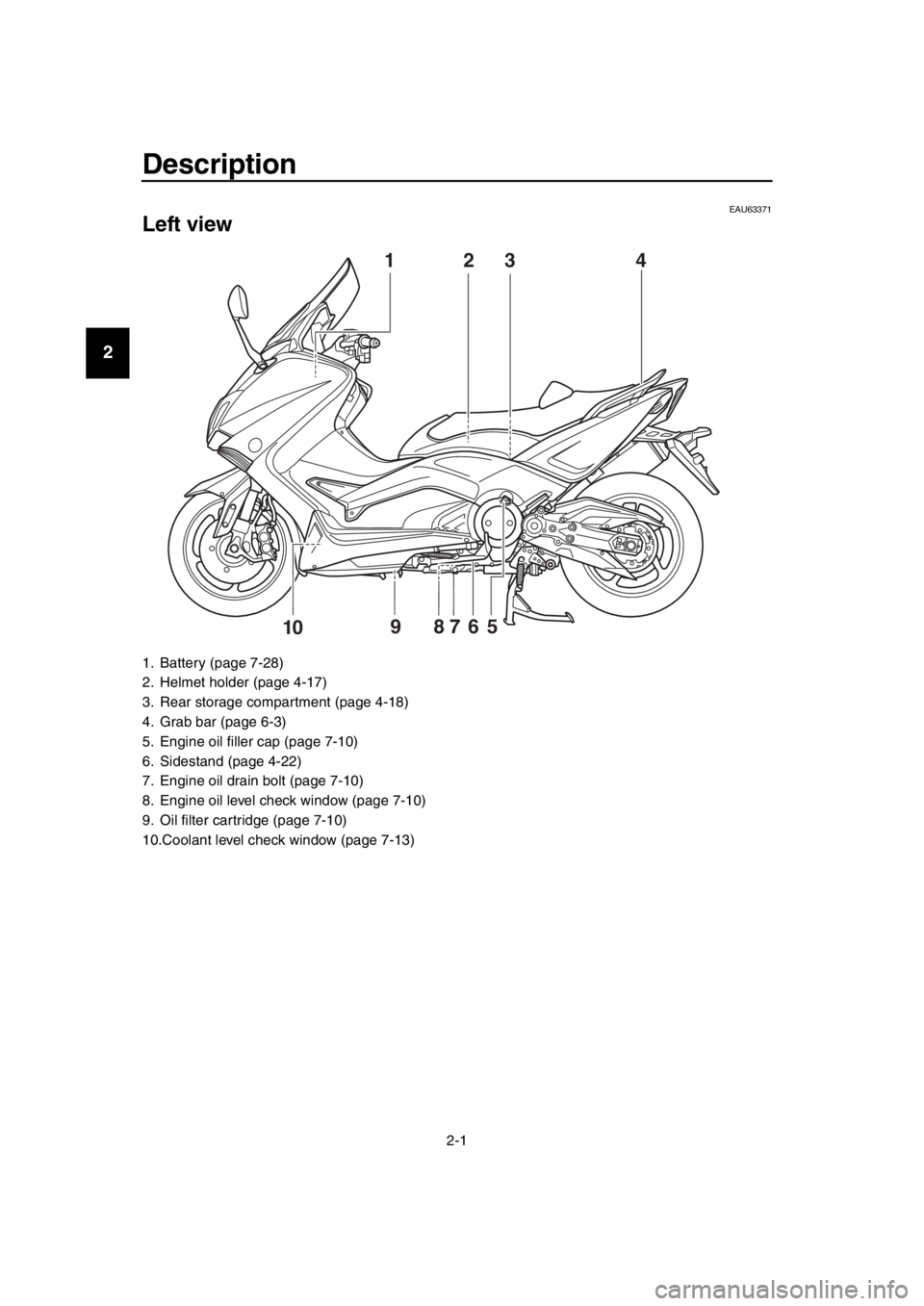
2-1
1
2
3
4
5
6
7
8
9
10
11
12
13
14
Description
EAU63371
Left view
1. Battery (page 7-28)
2. Helmet holder (page 4-17)
3. Rear storage compartment (page 4-18)
4. Grab bar (page 6-3)
5. Engine oil filler cap (page 7-10)
6. Sidestand (page 4-22)
7. Engine oil drain bolt (page 7-10)
8. Engine oil level check window (page 7-10)
9. Oil filter cartridge (page 7-10)
10.Coolant level check window (page 7-13)
3
59 87610
142
2PW-9-E1.book 1 ページ 2015年9月10日 木曜日 午後5時17分
Page 22 of 110

Smart key system
3-8
1
2
3
4
5
6
7
8
9
10
11
12
13
14
EAU61633
Vehicle power on and steering
lock release
1. With the smart key on and in oper- ating range, press the “ON/ ”
switch for one second.
2. Upon authentication of the smart key, the beeper will sound twice,
the smart key system indicator
light will come on momentarily and
the steering lock (if applied) will re-
lease automatically.
TIP
The smart key system indicator
light will flash if the steering lock
cannot automatically release itself.
Try moving the handlebars gently
to the left or right and then press
the “ON/ ” switch.
If the steering continues to be
locked and will not release, the
smart key system indicator light
will flash 16 times and the steering
lock release operation will stop
midway. Move the handlebar gen-
tly to the left and right to help re-
lease the steering lock and then
press the “ON/ ” switch again.
NOTICE
ECA15825
If the steering lock will not release
and the smart key system indicator
light is flashing, have a Yamaha
dealer check the smart key system.
3. The power of the vehicle is turned on once the steering lock is com-
pletely released. The smart key
system indicator light will go off
and the multi-function meter dis-
play will come on.
4. The engine can now be started. (See page 6-2.)
1. “ON/ ” switch
1
2PW-9-E1.book 8 ページ 2015年9月10日 木曜日 午後5時17分
Page 26 of 110
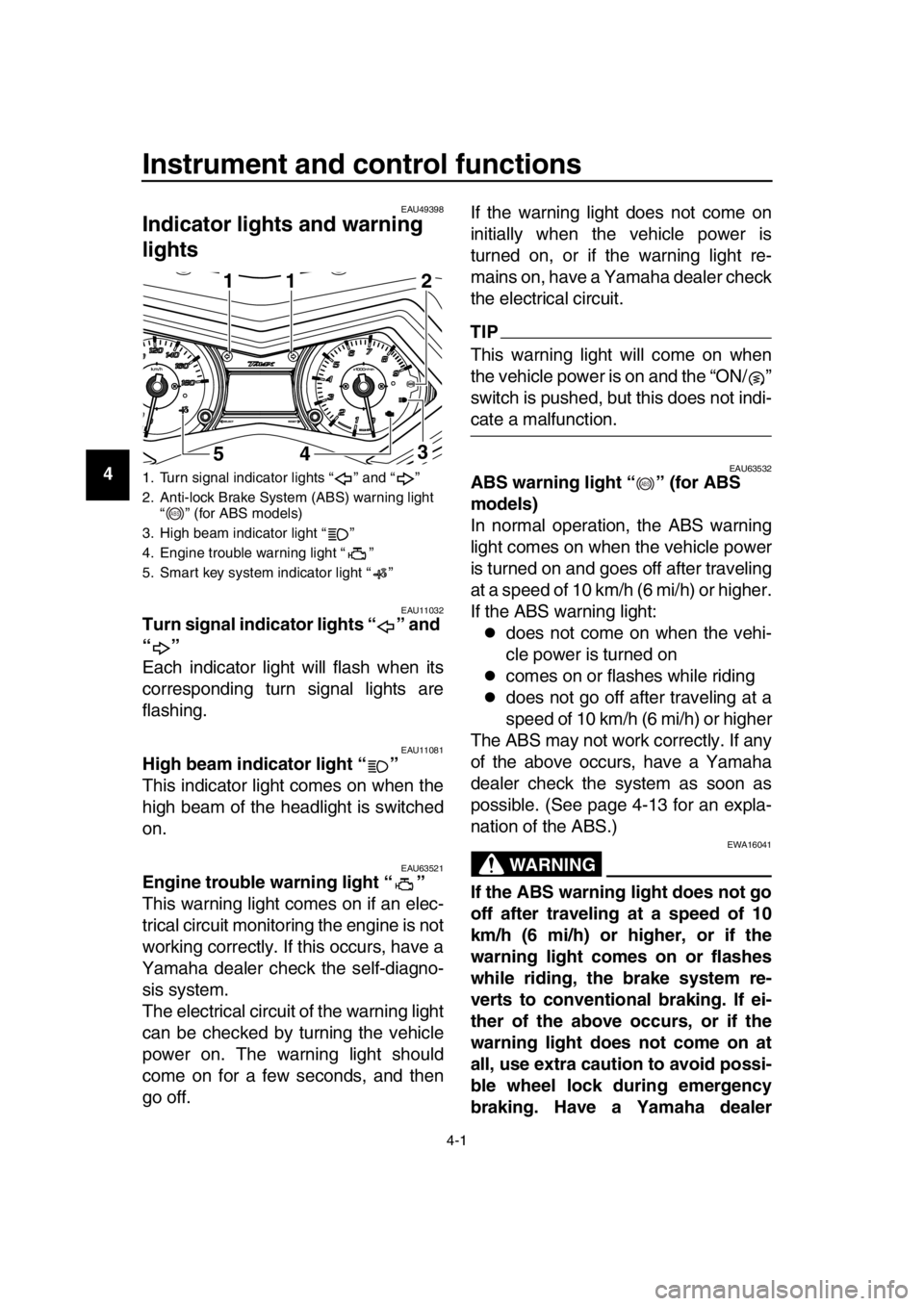
4-1
1
2
3
4
5
6
7
8
9
10
11
12
13
14
Instrument and control functions
EAU49398
Indicator ligh ts and warning
lights
EAU11032Turn signal indicator lights “ ” and
“”
Each indicator light will flash when its
corresponding turn signal lights are
flashing.
EAU11081High beam indicator light “ ”
This indicator light comes on when the
high beam of the headlight is switched
on.
EAU63521Engine trouble warning light “ ”
This warning light comes on if an elec-
trical circuit monitoring the engine is not
working correctly. If this occurs, have a
Yamaha dealer check the self-diagno-
sis system.
The electrical circuit of the warning light
can be checked by turning the vehicle
power on. The warning light should
come on for a few seconds, and then
go off. If the warning light does not come on
initially when the vehicle power is
turned on, or if the warning light re-
mains on, have a Yamaha dealer check
the electrical circuit.
TIP
This warning light will come on when
the vehicle power is on and the “ON/ ”
switch is pushed, but this does not indi-
cate a malfunction.
EAU63532ABS warning light “ ” (for ABS
models)
In normal operation, the ABS warning
light comes on when the vehicle power
is turned on and goes off after traveling
at a speed of 10 km/h (6 mi/h) or higher.
If the ABS warning light:
does not come on when the vehi-
cle power is turned on
comes on or flashes while riding
does not go off after traveling at a
speed of 10 km/h (6 mi/h) or higher
The ABS may not work correctly. If any
of the above occurs, have a Yamaha
dealer check the system as soon as
possible. (See page 4-13 for an expla-
nation of the ABS.)
WARNING
EWA16041
If the ABS warning light does not go
off after traveling at a speed of 10
km/h (6 mi/h) or higher, or if the
warning light comes on or flashes
while riding, the brake system re-
verts to conventional braking. If ei-
ther of the above occurs, or if the
warning light does not come on at
all, use extra caution to avoid possi-
ble wheel lock during emergency
braking. Have a Yamaha dealer
1. Turn signal indicator lights “ ” and “ ”
2. Anti-lock Brake System (ABS) warning light “ ” (for ABS models)
3. High beam indicator light “ ”
4. Engine trouble warning light “ ”
5. Smart key system indicator light “ ”
1
5411
3 2
ABS
ABS
2PW-9-E1.book 1 ページ 2015年9月10日 木曜日 午後5時17分
Page 27 of 110
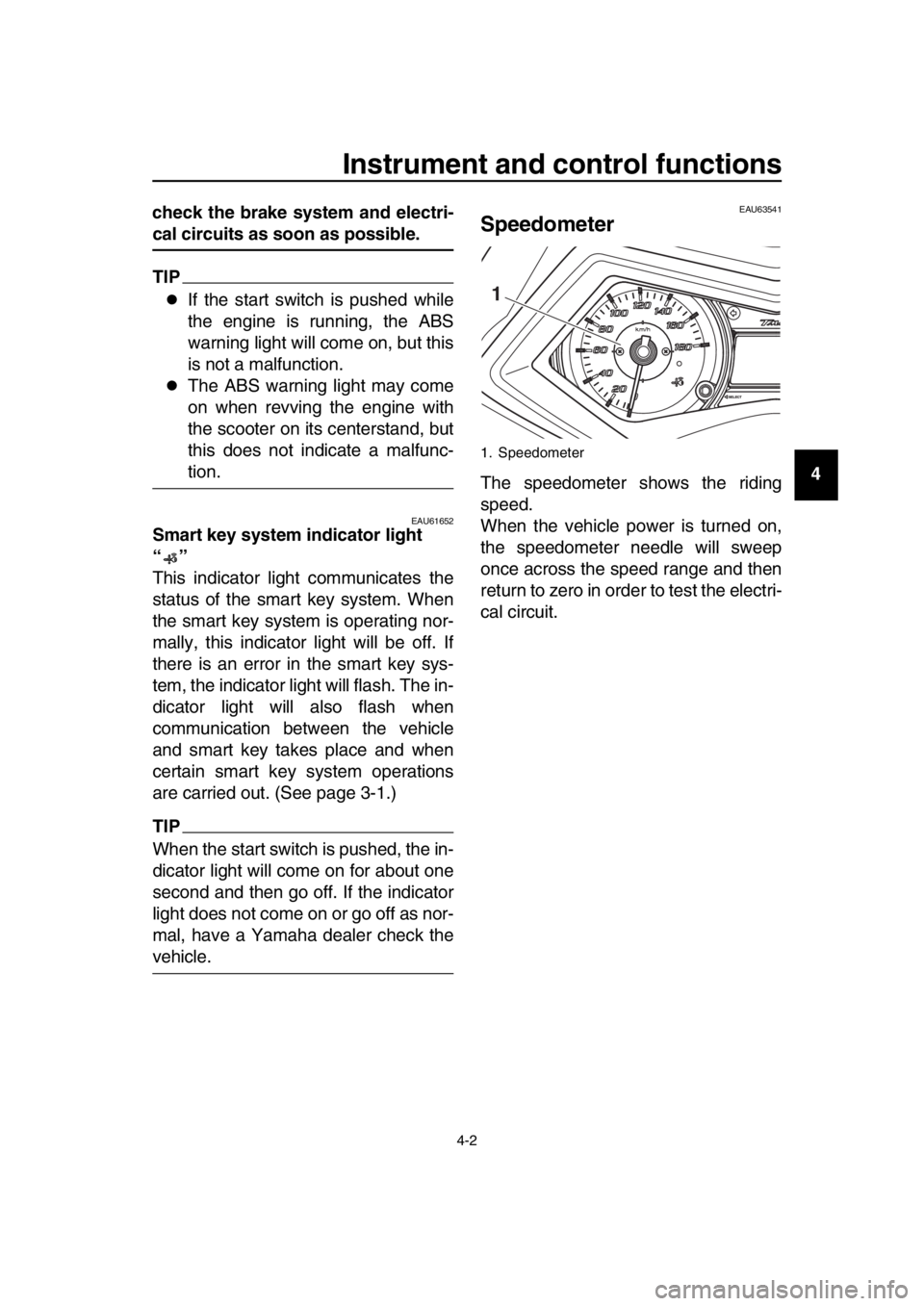
Instrument and control functions
4-2
1
2
3
4
5
6
7
8
9
10
11
12
13
14
check the brake system and electri-
cal circuits as soon as possible.
TIP
If the start switch is pushed while
the engine is running, the ABS
warning light will come on, but this
is not a malfunction.
The ABS warning light may come
on when revving the engine with
the scooter on its centerstand, but
this does not indicate a malfunc-
tion.
EAU61652Smart key system indicator light
“”
This indicator light communicates the
status of the smart key system. When
the smart key system is operating nor-
mally, this indicator light will be off. If
there is an error in the smart key sys-
tem, the indicator light will flash. The in-
dicator light will
also flash when
communication between the vehicle
and smart key takes place and when
certain smart key system operations
are carried out. (See page 3-1.)
TIP
When the start switch is pushed, the in-
dicator light will come on for about one
second and then go off. If the indicator
light does not come on or go off as nor-
mal, have a Yamaha dealer check the
vehicle.
EAU63541
Speedometer
The speedometer shows the riding
speed.
When the vehicle power is turned on,
the speedometer needle will sweep
once across the speed range and then
return to zero in order to test the electri-
cal circuit.
1. Speedometer
1
2PW-9-E1.book 2 ページ 2015年9月10日 木曜日 午後5時17分
Page 31 of 110
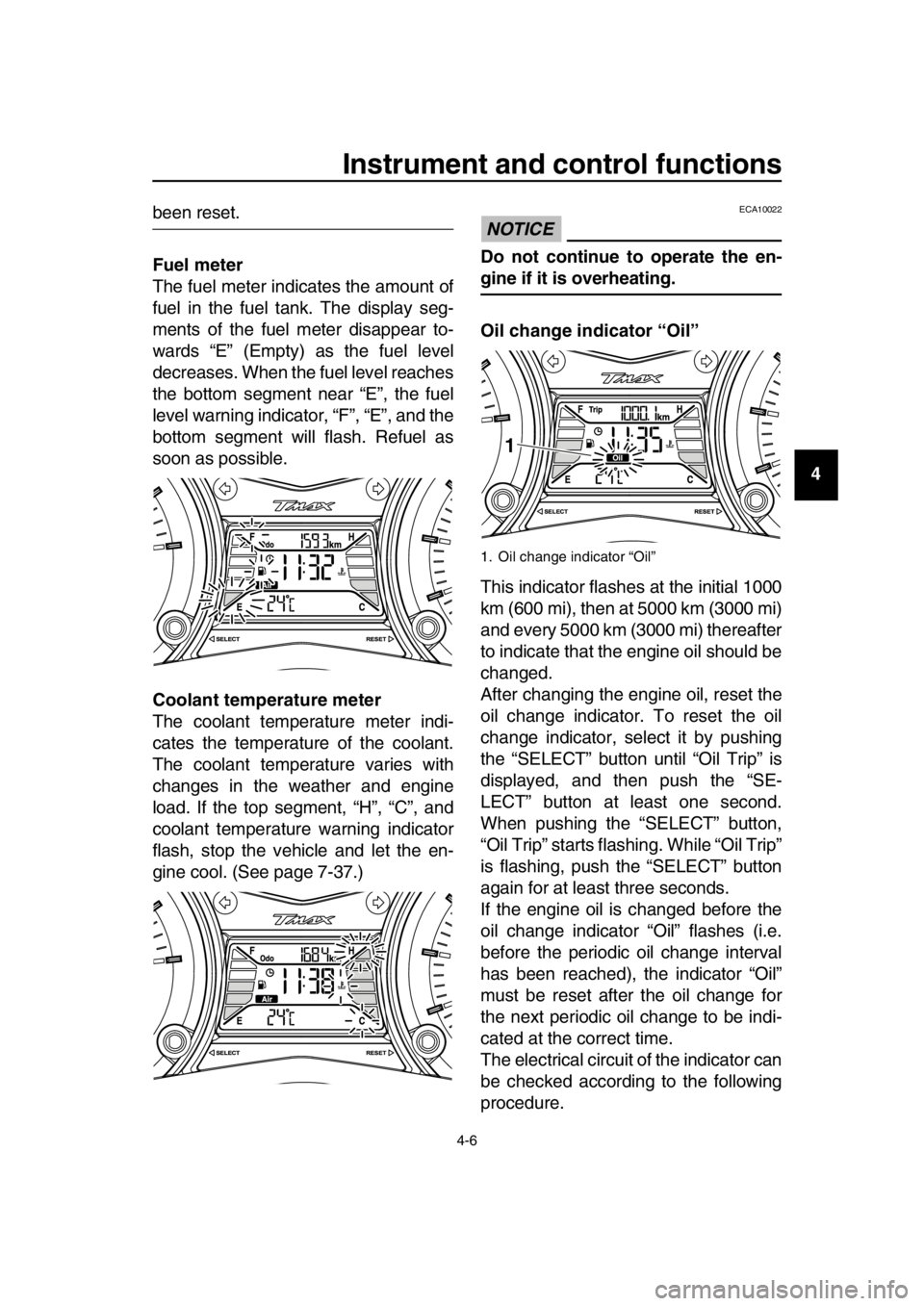
Instrument and control functions
4-6
1
2
3
4
5
6
7
8
9
10
11
12
13
14
been reset.
Fuel meter
The fuel meter indicates the amount of
fuel in the fuel tank. The display seg-
ments of the fuel meter disappear to-
wards “E” (Empty) as the fuel level
decreases. When the fuel level reaches
the bottom segment near “E”, the fuel
level warning indicator, “F”, “E”, and the
bottom segment will flash. Refuel as
soon as possible.
Coolant temperature meter
The coolant temperature meter indi-
cates the temperature of the coolant.
The coolant temperature varies with
changes in the weather and engine
load. If the top segment, “H”, “C”, and
coolant temperature warning indicator
flash, stop the vehicle and let the en-
gine cool. (See page 7-37.)NOTICE
ECA10022
Do not continue to operate the en-
gine if it is overheating.
Oil change indicator “Oil”
This indicator flashes at the initial 1000
km (600 mi), then at 5000 km (3000 mi)
and every 5000 km (3000 mi) thereafter
to indicate that the engine oil should be
changed.
After changing the engine oil, reset the
oil change indicator. To reset the oil
change indicator, select it by pushing
the “SELECT” button until “Oil Trip” is
displayed, and then push the “SE-
LECT” button at least one second.
When pushing the “SELECT” button,
“Oil Trip” starts flashing. While “Oil Trip”
is flashing, push the “SELECT” button
again for at least three seconds.
If the engine oil is changed before the
oil change indicator “Oil” flashes (i.e.
before the periodic oil change interval
has been reached), the indicator “Oil”
must be reset after the oil change for
the next periodic oil change to be indi-
cated at the correct time.
The electrical circuit of the indicator can
be checked according to the following
procedure.
1. Oil change indicator “Oil”
1
2PW-9-E1.book 6 ページ 2015年9月10日 木曜日 午後5時17分
Page 32 of 110

Instrument and control functions
4-7
1
2
3
4
5
6
7
8
9
10
11
12
13
14 1. Set the engine stop switch to “ ”
and turn the power of the vehicle
on.
2. Check that the oil change indicator
comes on for a few seconds and
then goes off.
3. If the oil change indicator does not come on, have a Yamaha dealer
check the electrical circuit.
V-belt replacement indicator
“V-Belt”
This indicator flashes every 20000 km
(12500 mi) when the V-belt needs to be
replaced.
After changing the V-belt, reset the
V-belt replacement indicator. To reset
the V-belt replacement indicator, select
it by pushing the “SELECT” button until
“V-Belt Trip” is displayed, and then
push the “SELECT” button at least one
second. When pushing the “SELECT”
button, “V-Belt Trip” starts flashing.
While “V-Belt Trip” is flashing, push the
“SELECT” button for at least three sec-
onds.
If the V-belt is changed before the
V-belt replacement indicator “V-Belt”
flashes (i.e. before the periodic V-belt
change interval has been reached), the
indicator “V-Belt” must be reset after the V-belt change for the next periodic
V-belt change to be indicated at the
correct time.
The electrical circuit of the indicator can
be checked according to the following
procedure.
1. Turn the vehicle on and make sure that the engine stop switch is set to
“”.
2. Check that the V-belt replacement indicator comes on for a few sec-
onds and then goes off.
3. If the V-belt replacement indicator does not come on, have a Yamaha
dealer check the electrical circuit.
Ambient temperature display, aver-
age fuel consumption, and instan-
taneous fuel consumption modes
Push the “RESET” button to switch the
display between the ambient tempera-
ture display “Air”, the average fuel con-
sumption mode “AVE_ _._ km/L” or
“AVE_ _._ L/100 km”, and the instanta-
neous fuel consumption mode “km/L”
or “L/100 km” in the following order:
Air AVE_ _._ km/L or AVE_ _._
L/100 km km/L or L/100 km Air
1. V-belt replacement indicator “V-Belt”
1
1. Ambient temperature/average fuel
consumption/instantaneous fuel
consumption
1
2PW-9-E1.book 7 ページ 2015年9月10日 木曜日 午後5時17分
Page 34 of 110

Instrument and control functions
4-9
1
2
3
4
5
6
7
8
9
10
11
12
13
14 Instantaneous fuel consumption modeThis mode calculates the current fuel
consumption rate of the vehicle every
few seconds.
For the UK:
The instantaneous fuel consumption is
displayed “MPG”.
When the display is set to “km/L”,
the distance that can be traveled
on 1.0 L of fuel under the current
riding conditions is shown.
When the display is set to “L/100
km”, the amount of fuel necessary
to travel 100 km under the current
riding conditions is shown.
For the UK: The distance that can
be traveled on 1.0 Imp.gal of fuel
under the current riding conditions
is shown.
To switch between the instantaneous
fuel consumption displays, push the
“RESET” button for one second when
one of the displays is shown (except for
the UK).
TIP
If traveling at speeds under 10 km/h (6
mi/h), “_ _._” is displayed. Self-diagnosis device
This model is equipped with a self-diag-
nosis device for vari
ous electrical cir-
cuits.
If a problem is detected in any of those
circuits, the engine trouble warning light
comes on and the display indicates an
error code.
If the display indicates any error codes,
note the code number, and then have a
Yamaha dealer check the vehicle.
NOTICE
ECA11591
If the display indicates an error
code, the vehicle should be checked
as soon as possible in order to avoid
engine damage.
1. Instantaneous fuel consumption display
1
1. Error code display
1
2PW-9-E1.book 9 ページ 2015年9月10日 木曜日 午後5時17分
Page 47 of 110
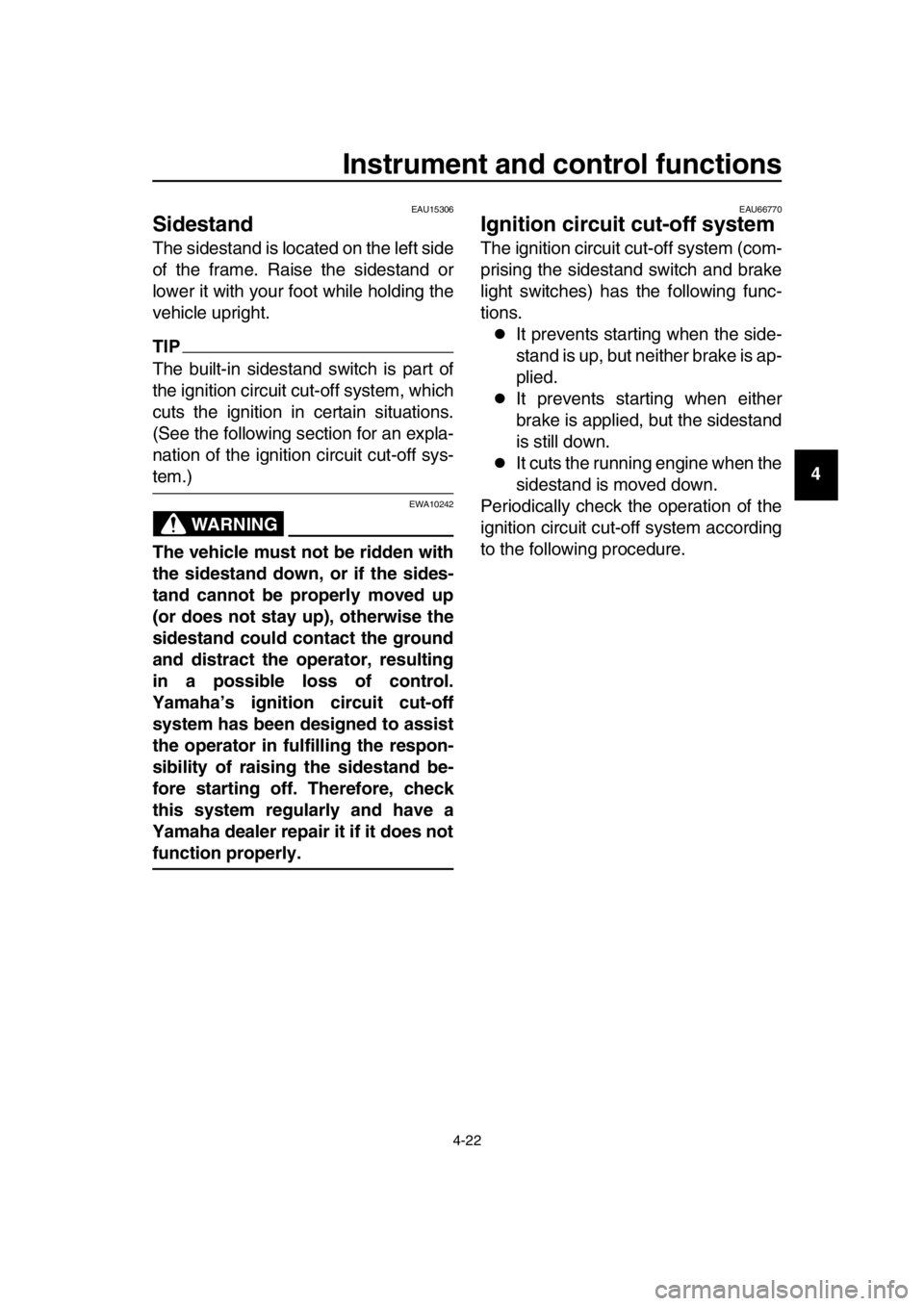
Instrument and control functions
4-22
1
2
3
4
5
6
7
8
9
10
11
12
13
14
EAU15306
Sidestand
The sidestand is located on the left side
of the frame. Raise the sidestand or
lower it with your foot while holding the
vehicle upright.
TIP
The built-in sidestand switch is part of
the ignition circuit cut-off system, which
cuts the ignition in certain situations.
(See the following section for an expla-
nation of the ignition circuit cut-off sys-
tem.)
WARNING
EWA10242
The vehicle must not be ridden with
the sidestand down, or if the sides-
tand cannot be properly moved up
(or does not stay up), otherwise the
sidestand could contact the ground
and distract the operator, resulting
in a possible loss of control.
Yamaha’s ignition circuit cut-off
system has been designed to assist
the operator in fulfilling the respon-
sibility of raising the sidestand be-
fore starting off. Therefore, check
this system regularly and have a
Yamaha dealer repair it if it does not
function properly.
EAU66770
Ignition circuit cut-off system
The ignition circuit cut-off system (com-
prising the sidestand switch and brake
light switches) has the following func-
tions.
It prevents starting when the side-
stand is up, but neither brake is ap-
plied.
It prevents starting when either
brake is applied, but the sidestand
is still down.
It cuts the running engine when the
sidestand is moved down.
Periodically check the operation of the
ignition circuit cut-o ff system according
to the following procedure.
2PW-9-E1.book 22 ページ 2015年9月10日 木曜日 午後5時17分